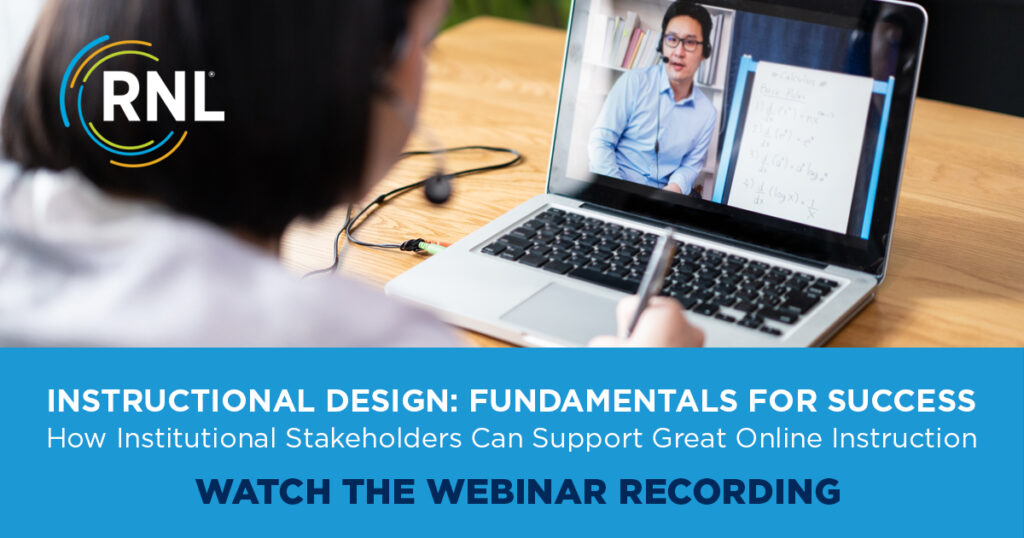enrollment
Instructional Design: The (Often) Overlooked Driver of Campus Success

High-quality instructional design is the backbone of an impactful student learning experience. Enrollment and retention efforts benefit from programs and courses that engage students and teach them the skills needed to advance their careers. And graduating students who become successful in their fields can also enhance your campus’s reputation and advancement strategy. However, because the instructional design process is done behind the scenes, it can be easy to overlook the critical role it plays in your institution’s success.
Strong instructional design results in high-quality curriculum that provides enriched learning and a dynamic student experience. But how do you know if your institution is providing quality courses? RNL’s The Instructional Design: Fundamentals for Success on-demand webinar goes into more detail, but the following list describes the hallmarks of quality online courses:
- Clear, measurable learning objectives as a basis for alignment—Measurable learning objectives, determined by your institution’s faculty, define what students will know and do when they complete their studies. These objectives guide other course design decisions and give students tangible goals for their learning.
- Opportunities for meaningful interaction—Meaningful interaction with the instructor, with classmates, and with the content of the course promotes student engagement and emotional investment in your institution.
- Authentic and scaffolded assessments—Authentic and scaffolded assessments are those that students can highlight in an interview or within a portfolio to demonstrate their development and growth. Assignments are deliberately aligned to the objectives and are useful and relevant to the student experience.
- Diverse, accessible, and media-rich learning resources—Carefully created and curated content engages students while context from your expert faculty members frames what students need to know to apply their learning to the real world. The principles of universal design recommend that resources are usable, inclusive, and accessible for all students regardless of their needs.
Once you understand the value of instructional design, you begin to realize just how critical it is to create a unified instructional design approach at your institution. There are several key areas that are particularly important to address: infrastructure and planning, quality, and institutional culture. You can read about these in more detail in the Instructional Design Best Practices guide (you can download this and the other guides in our Own and Transform Your Enrollment series).
Infrastructure and planning
When it comes to instructional design, the importance of solid infrastructure and planning processes cannot be underestimated. This includes your design team, your process, and even your institution’s suite of learning technologies.
A strong instructional design team will be familiar with instructional design processes, theories, and models as well as various instructional technologies. Communication and conflict resolution skills are also invaluable, and some experience working as faculty is also useful.
But a strong team is only the beginning. Defining and operationalizing the process of instructional design is just as critical. Project management tools such as Wrike, Asana, Trello, or Smartsheet can help your instructional design team with resource allocation. Additionally, your design team brings expertise on various models of instructional design so that you can use or adapt them to fit your institution’s needs.
Your institution’s learning management system (LMS), video recording platform, and multimedia tools are also important infrastructure considerations. Institutional licenses to video recording platforms and multimedia creation tools allow broad access to faculty, instructional designers, and students. Learning technologies that are institutionally supported and scalable are an asset to your institution on many levels beyond the instructional design process.
Elevate the online learning experience with expert instructional design
RNL’s Instructional Design team is made up of industry experts in education and technology. Talk with us about how you can develop new courses and optimize your current ones to transform your online course offerings into the best of the best.
Quality
Successful instructional design requires strong quality assurance and review processes. Luckily, there are many established frameworks for reviewing quality in online courses, so you don’t need to start from scratch to develop your institution’s standards. Quality Matters, SYNY Online, and the University of Illinois offer online course design quality measurement tools that can be used as is or adapted to better fit your institution’s specific needs. Accessibility is an important component of any quality course. The instructional design process promotes a proactive approach to accessibility, and your LMS may offer many tools to help your instructional designers and faculty check and address the accessibility of course content.
Institutional culture
Institutional culture is important to consider when assessing your instructional design process, particularly when it comes to recognizing the time, effort, and spirit of collaboration involved in designing high-quality courses. Your faculty know what students need to be successful in their fields, and they feel appreciated and valued when they are appropriately compensated for their course design efforts. Finding instructional design champions among your faculty will help you develop a culture that values intentionality, planning, organization, and consistency within courses and programs.
As you can see, instructional design is not something that happens once; it’s a process of continuous improvement and refinement that results in courses and programs that benefit your students, faculty, and ultimately, the institution itself.
As you review your institution’s current instructional design processes, ask yourself the following questions to help you amp up the important work you do:
- What are we already doing well regarding our instructional design process?
- What can we do to make our instructional design process better?
- What can we do to innovate our instructional design process?
Need help with your instructional design process?
I invite you to watch our webinar Instructional Design: Fundamentals of Success. We discuss the fundamentals of great online course design in a way that will help every stakeholder at your institution understand best practices and then advocate for excellence in your instructional design process.
Our instructional design also works with dozens of institutions on their instructional design and ensure that students have the best in-class learning experience. We are ready to collaborate with your faculty and other academic stakeholders to design the high-quality online programs and courses you need to be successful. Reach out for a complimentary consultation and we can discuss how we can help you.

